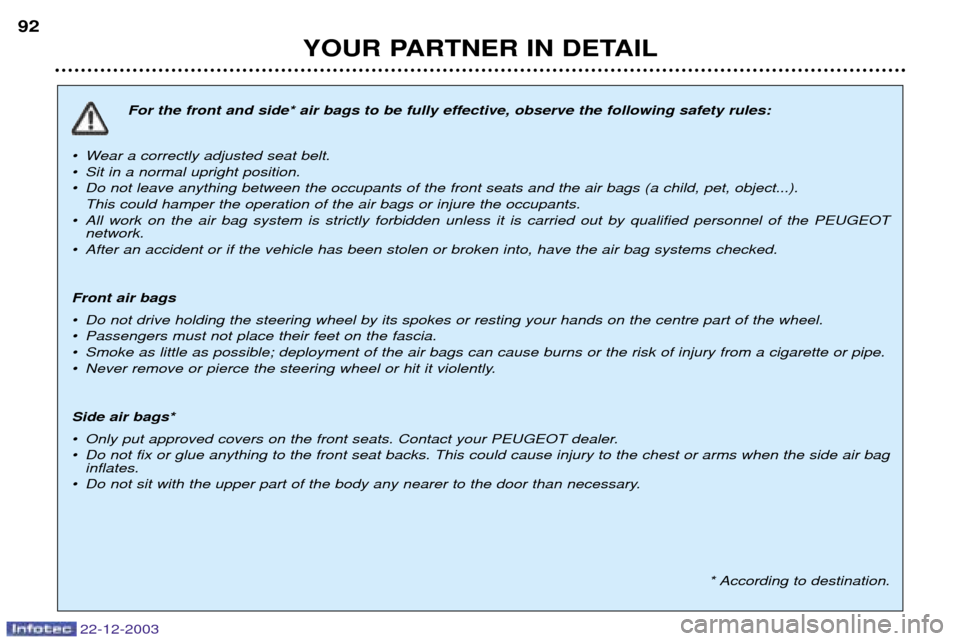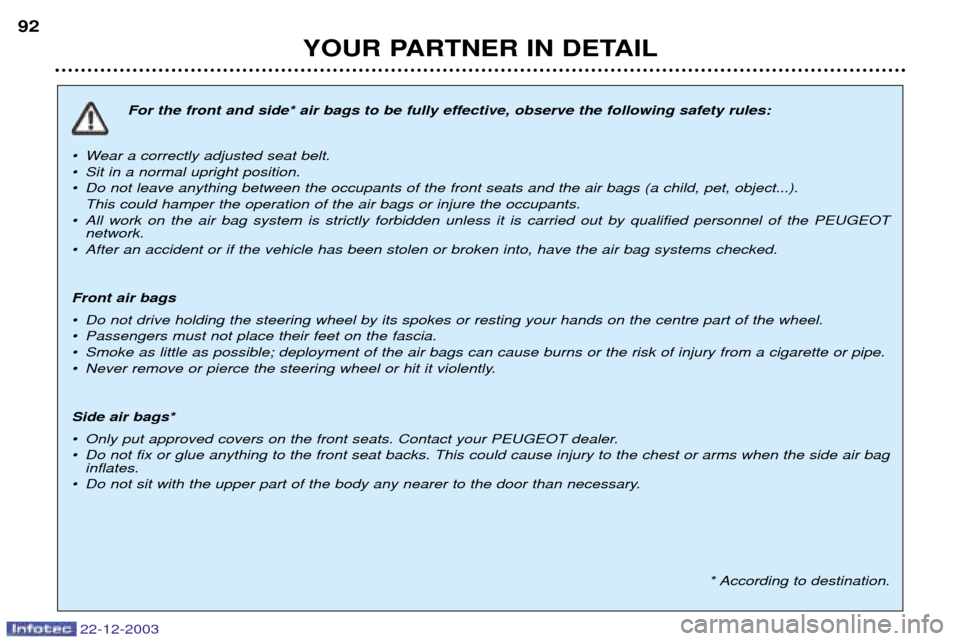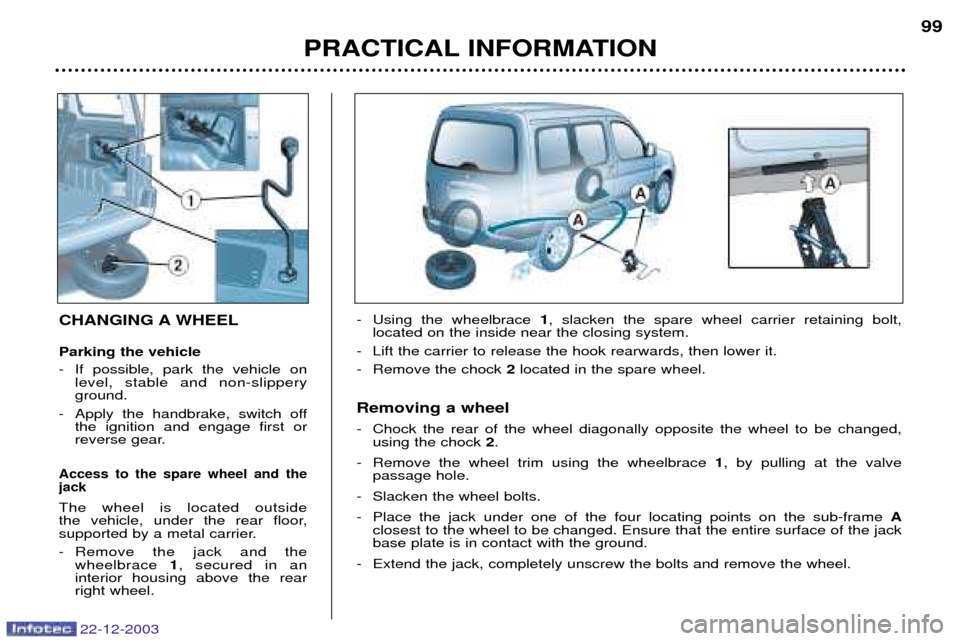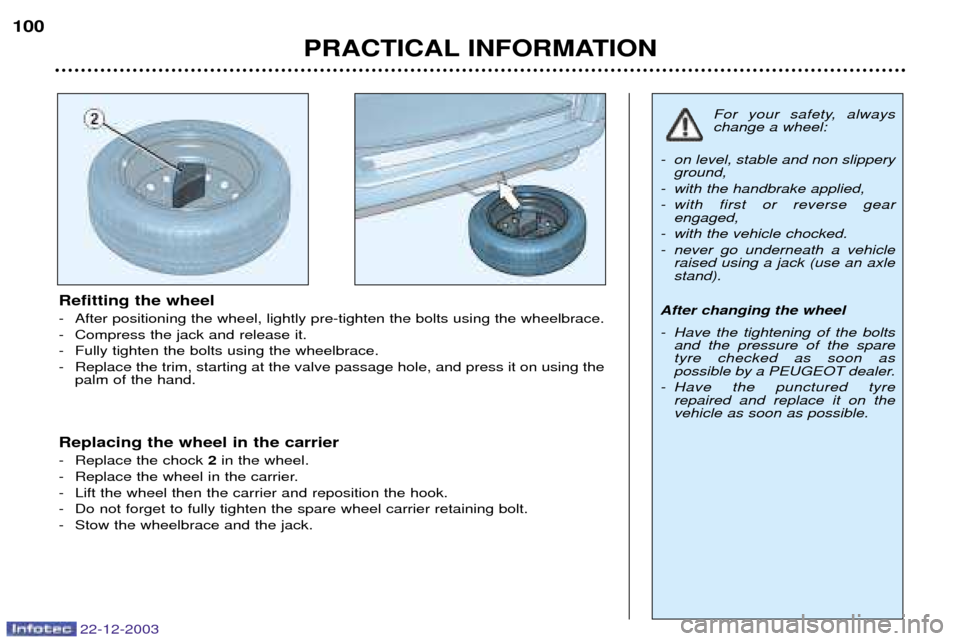Page 94 of 128

22-12-2003
Disarming the passenger air bag*
To ensure the safety of your child, it is essential to disarm the pas-senger air bag when you install arear-facing child seat on the frontpassenger seat. Otherwise, thechild would risk being killed orseriously injured if the air bagwere to inflate. �With the ignition switched off ,
insert the key into the passenger air bag disarming switch 1, turn it
to the "OFF" position, then remo-
ve the key keeping the slot in thisposition.
The air bag warning lighton the instrument panel islit throughout the disarmingprocess.
* According to destination.
YOUR PARTNER IN DETAIL
90
FRONT AIR BAGS These are folded in the centre of the steering wheel for the driver and in
the fascia for the front passenger.
They are deployed simultaneously,except in cases where the passengerair bag is disarmed. Front air bag fault
If this warning light comes onon the instrument panel, accompanied by an audiblesignal, contact a PEUGEOT
dealer to have the systemchecked.
AIR BAGS The air bags have been designed to maximise the safety of the occupants in the event of serious
collisions. They work in conjunctionwith the pretensioning seat belts. The electronic detectors register and analyse any abrupt decelerationof the vehicle: if the triggering threshold is reached, the air bagsinflate instantly and protect theoccupants of the vehicle. Immediately after the impact, the air bags deflate rapidly so that they donot hinder the visibility of the occupants nor their exit if necessaryfrom the vehicle. The air bags are not deployed in the case of minor collisions, for which
the seat belt is sufficient to ensure
maximum protection. The serious-ness of a collision depends on thenature of the obstacle and the speedof the vehicle at the moment ofimpact. Air bags only operate when the ignition is switched on. Note:
the gas escaping from the air
bags can be a minor irritant.
Page 96 of 128

22-12-2003
YOUR PARTNER IN DETAIL
92
For the front and side* air bags to be fully effective, observe the following safety rules:
¥ Wear a correctly adjusted seat belt.
¥ Sit in a normal upright position.
¥ Do not leave anything between the occupants of the front seats and the air bags (a child, pet, object...). This could hamper the operation of the air bags or injure the occupants.
¥ All work on the air bag system is strictly forbidden unless it is carried out by qualified personnel of the PEUGEOT network.
¥ After an accident or if the vehicle has been stolen or broken into, have the air bag systems checked. Front air bags
¥ Do not drive holding the steering wheel by its spokes or resting your hands on the centre part of the wheel.
¥ Passengers must not place their feet on the fascia.
¥ Smoke as little as possible; deployment of the air bags can cause burns or the risk of injury from a cigarette or pipe.
¥ Never remove or pierce the steering wheel or hit it violently. Side air bags*
¥ Only put approved covers on the front seats. Contact your PEUGEOT dealer.
¥ Do not fix or glue anything to the front seat backs. This could cause injury to the chest or arms when the side air bag inflates.
¥ Do not sit with the upper part of the body any nearer to the door than necessary.
* According to destination.
Page 98 of 128

22-12-2003
YOUR PARTNER IN DETAIL
92
For the front and side* air bags to be fully effective, observe the following safety rules:
¥ Wear a correctly adjusted seat belt.
¥ Sit in a normal upright position.
¥ Do not leave anything between the occupants of the front seats and the air bags (a child, pet, object...). This could hamper the operation of the air bags or injure the occupants.
¥ All work on the air bag system is strictly forbidden unless it is carried out by qualified personnel of the PEUGEOT network.
¥ After an accident or if the vehicle has been stolen or broken into, have the air bag systems checked. Front air bags
¥ Do not drive holding the steering wheel by its spokes or resting your hands on the centre part of the wheel.
¥ Passengers must not place their feet on the fascia.
¥ Smoke as little as possible; deployment of the air bags can cause burns or the risk of injury from a cigarette or pipe.
¥ Never remove or pierce the steering wheel or hit it violently. Side air bags*
¥ Only put approved covers on the front seats. Contact your PEUGEOT dealer.
¥ Do not fix or glue anything to the front seat backs. This could cause injury to the chest or arms when the side air bag inflates.
¥ Do not sit with the upper part of the body any nearer to the door than necessary.
* According to destination.
Page 105 of 128

22-12-2003
PRACTICAL INFORMATION99
CHANGING A WHEEL Parking the vehicle
- If possible, park the vehicle on
level, stable and non-slippery ground.
- Apply the handbrake, switch off the ignition and engage first or
reverse gear.
Access to the spare wheel and thejack
The wheel is located outside
the vehicle, under the rear floor,
supported by a metal carrier.
- Remove the jack and the wheelbrace 1, secured in an
interior housing above the rear right wheel. - Using the wheelbrace
1, slacken the spare wheel carrier retaining bolt,
located on the inside near the closing system.
- Lift the carrier to release the hook rearwards, then lower it.
- Remove the chock 2located in the spare wheel.
Removing a wheel
- Chock the rear of the wheel diagonally opposite the wheel to be changed, using the chock 2.
- Remove the wheel trim using the wheelbrace 1, by pulling at the valve
passage hole.
- Slacken the wheel bolts.
- Place the jack under one of the four locating points on the sub-frame A
closest to the wheel to be changed. Ensure that the entire surface of the jack base plate is in contact with the ground.
- Extend the jack, completely unscrew the bolts and remove the wheel.
Page 106 of 128

22-12-2003
PRACTICAL INFORMATION
100
Refitting the wheel
- After positioning the wheel, lightly pre-tighten the bolts using the wheelbrace.
- Compress the jack and release it.
- Fully tighten the bolts using the wheelbrace.
- Replace the trim, starting at the valve passage hole, and press it on using the
palm of the hand.
Replacing the wheel in the carrier
- Replace the chock 2in the wheel.
- Replace the wheel in the carrier.
- Lift the wheel then the carrier and reposition the hook.
- Do not forget to fully tighten the spare wheel carrier retaining bolt.
- Stow the wheelbrace and the jack.
For your safety, always change a wheel:
- on level, stable and non slippery ground,
- with the handbrake applied,
- with first or reverse gear engaged,
- with the vehicle chocked.
- never go underneath a vehicle raised using a jack (use an axle stand).
After changing the wheel
- Have the tightening of the bolts and the pressure of the spare tyre checked as soon as
possible by a PEUGEOT dealer.
- Have the punctured tyre repaired and replace it on thevehicle as soon as possible.
Page 107 of 128
22-12-2003
Anti-theft bolt* If your wheels are fitted with an anti-theft bolt (one per wheel), it must beunscrewed using one of the two anti-theft sockets (which were given toyou on delivery of your vehicle alongwith the duplicate keys and the confi-dential card) and the wheelbrace. Note:make a careful note of the
code number engraved on the top of
the anti-theft socket. This will enableyou to obtain a duplicate anti-theft
socket from your Peugeot dealer.
* According to model and destination.
SPECIAL FEATURES OF
ALLOY WHEELS Fitting the spare wheel If your vehicle is equipped with a steel spare wheel, when fitting it, it isnormal
to notice that the bolt
washers do not come into contact
with the rim. The spare wheel issecured by the cone-shape of eachbolt. Fitting snow tyres If you fit snow tyres that are mounted on steel rims onto your vehicle, it isessential that you use special bolts
available from your PEUGEOT
dealer.
PRACTICAL INFORMATION 101
Page 116 of 128
Fuse RatingFunctions
1 15A Rear wiper (hinged doors) - Rear 12 V sockets.
4 20A Multi-function display - Instrument panel - Audio equipment - Steering wheel controls.
5 15A Alarm siren.
6 10A Diagnostic socket.
7 15A Alarm.
9 30A Heated seats - Zenith roof fan.
10 40A Rear screen and mirror demisting.
11 15A Rear windscreen wiper (tailgate).
12 30A Front electric windows - Sunroof.
14 10A Engine fuse box - Steering wheel controls - Rain sensor.
15 15A Instrument panel - Multi-function display - Audio equipment.
16 30A Locking/unlocking controls for doors, bonnet and boot.
20 10A Right-hand brake light.
21 15A Left-hand brake light.
22 20A Front courtesy light - Map reading light - Lighter - Front 12 V socket -
Electric mirror.
PRACTICAL INFORMATION 107
22-12-2003
Page 119 of 128
22-12-2003
PRACTICAL INFORMATION
112
TOWING YOUR VEHICLE
Without lifting (four wheels on the ground)
You must always use a tow bar. From the front or the rear Attach the tow bar to the towing eye. By lifting (two wheels only on the ground) It is preferable to lift the vehicle by the wheels.
SNOW SCREEN*The snow screen is installed on the lower part of the front bumper to pre-vent the accumulation of snow at theradiator cooling fan. When the snow has cleared, do not forget to remove the snowscreen. FITTING �
Offer up the snow screen facing its centring pin Aon the front
bumper.
� Put it in place by pressing ateach clip Blocated in the four
corners.
REMOVAL � Pass a screwdriver into the hole located near each of the clips.
� Use the screwdriver as a lever tounclip the four clips Bin turn.
* According to destination.
Never use the radiator crossmember.